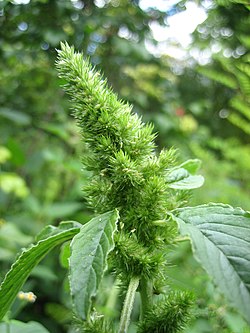This article possibly contains original research .(August 2021) |
| Amaranthus retroflexus | |
|---|---|
 | |
| Scientific classification | |
| Kingdom: | Plantae |
| Clade: | Tracheophytes |
| Clade: | Angiosperms |
| Clade: | Eudicots |
| Order: | Caryophyllales |
| Family: | Amaranthaceae |
| Genus: | Amaranthus |
| Species: | A. retroflexus |
| Binomial name | |
| Amaranthus retroflexus | |
| Synonyms [2] [3] | |
| |
Amaranthus retroflexus is a species of flowering plant in the family Amaranthaceae with several common names, including red-root amaranth, redroot pigweed, red-rooted pigweed, common amaranth, pigweed amaranth, and common tumbleweed. [4]
Contents
- Description
- Distribution and habitat
- As a weed
- Potential toxicity
- Uses
- Culinary
- As fodder
- References
- External links
Outside of its native range, it is considered a weed. Although it may be toxic if eaten uncooked, or in excess by livestock, it can be consumed as a vegetable or as fodder.


